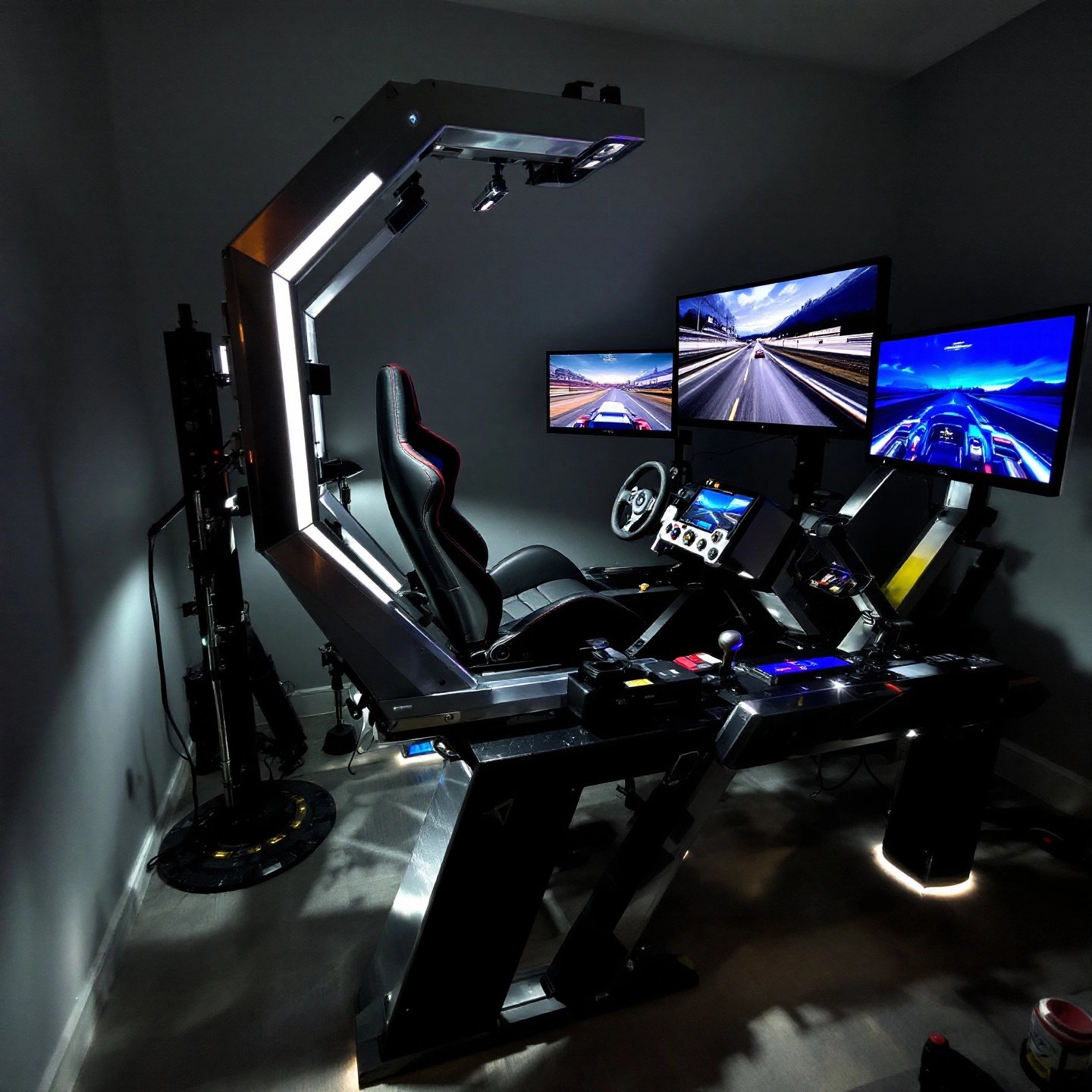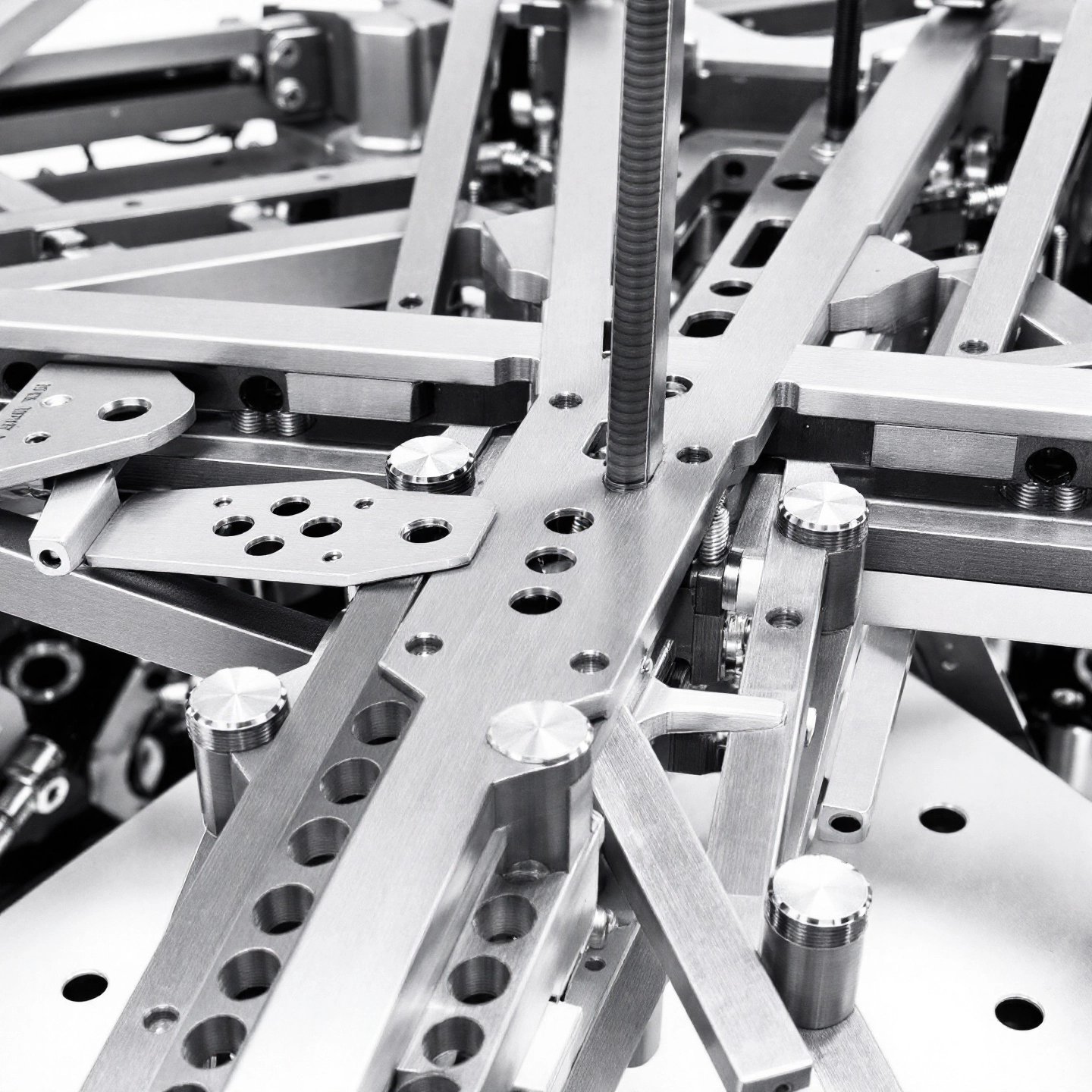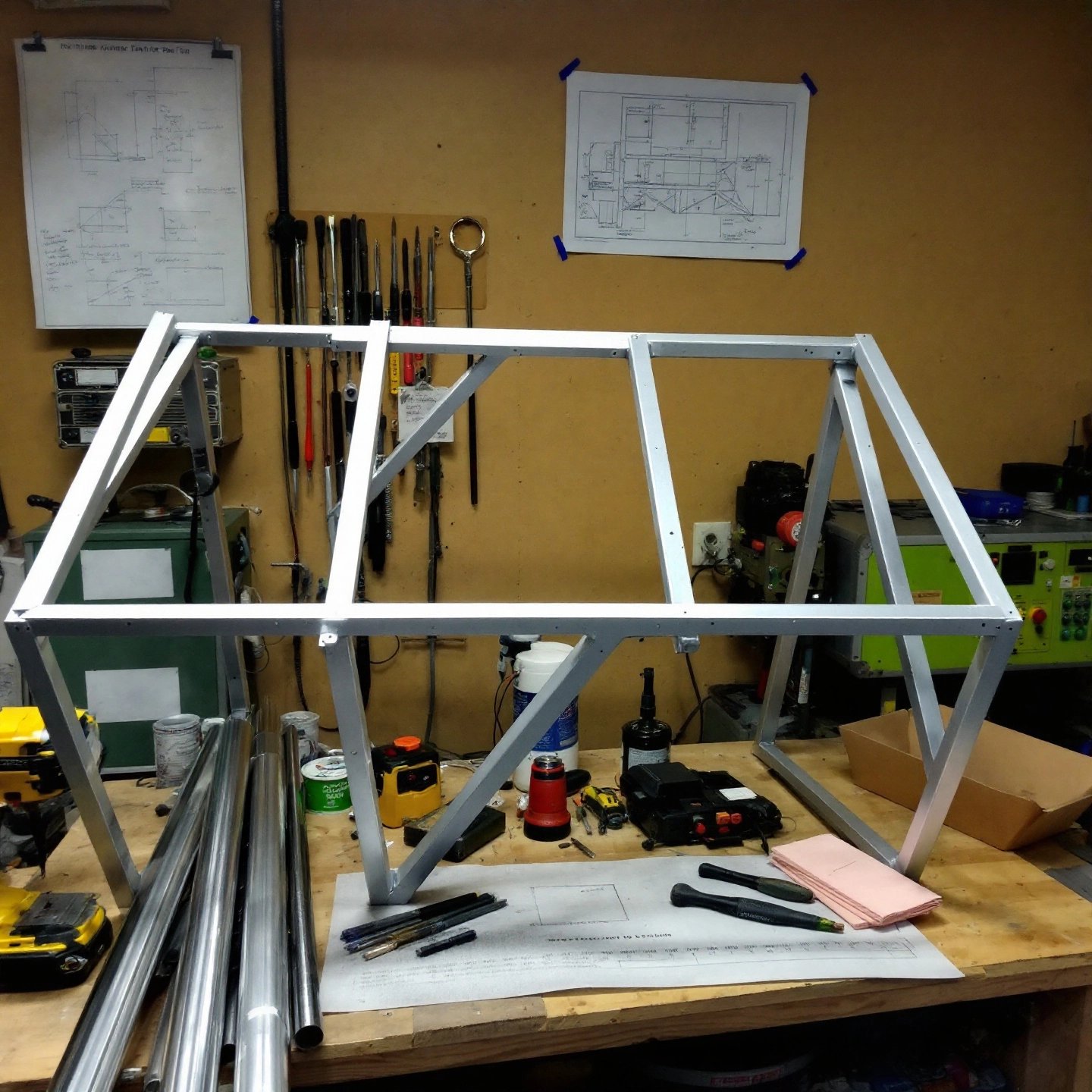
In the world of sim racing, where precision and realism are paramount, the aluminum sim rig stands out as a critical component for enthusiasts and professionals alike. But what exactly is an aluminum sim rig? At its core, it is a robust and adaptable platform designed to house all the essential equipment for driving simulations, such as steering wheels, pedals, and monitors. The use of aluminum profiles in these rigs provides unparalleled sturdiness and flexibility, allowing users to customize their setups to fit their specific needs.
The popularity of aluminum sim rigs has surged in recent years, and for good reason. These rigs offer a perfect blend of durability and customization, making them ideal for sim racers at any level—from beginners to seasoned pros. Unlike traditional wooden or steel rigs, aluminum offers a lightweight yet incredibly strong structure that can withstand the intense forces generated by high-performance racing equipment. This ensures that every twist and turn in a virtual race is translated with precision, enhancing the overall immersive experience.
This blog will guide you through the essentials of mastering an aluminum sim rig, offering insights into why these setups have become a staple in the sim racing community. We'll explore the components that make up these rigs, compare different materials, and provide tips on building your own setup. Whether you're looking to upgrade your current rig or dive into the world of sim racing for the first time, this comprehensive guide will equip you with the knowledge to make informed decisions and elevate your racing thrills. So, buckle up and get ready to explore the high-speed world of aluminum sim rigs.
In the realm of sim racing, the choice of materials for your rig can significantly influence your overall experience. Aluminum racing rigs have emerged as a favored option among enthusiasts due to their unique benefits over other materials like wood and steel. But what makes aluminum such a compelling choice for sim rig materials?
Firstly, aluminum profiles are renowned for their durability . Unlike wood, which can warp over time, or steel, which can be cumbersome, aluminum offers a perfect balance of strength and weight. This ensures that your rig remains a stable platform, capable of handling the intense forces exerted by high-performance racing equipment. The longevity of aluminum means that once you invest in a sim rig, it will serve you well for years, maintaining its structural integrity and performance.
Another significant advantage is adjustability . Aluminum profiles are highly modular, allowing for easy customization and expansion. This means you can tailor your setup to your specific needs, adjusting components like the seat, wheel, and pedal positions to achieve optimal ergonomics. This flexibility is particularly beneficial for sim racers who frequently upgrade their equipment or wish to experiment with different configurations.
In summary, aluminum racing rigs strike a perfect balance between durability, adjustability, and overall value. They offer the best of both worlds, providing a stable, lightweight, and customizable framework that enhances the racing experience by reducing unwanted flex and allowing for easy upgrades. As such, they have become the go-to choice for serious sim racers who demand both performance and adaptability from their setups.
As we delve further into the components that make up these rigs, you'll see how each piece plays a crucial role in building a racing setup that meets both your current needs and future aspirations.

Building a reliable aluminum sim rig involves understanding the essential components that form its backbone. A well-constructed rig not only enhances your racing experience but also ensures longevity and adaptability for future upgrades. Let's delve into the key elements that make up a robust aluminum sim rig.
These components interlock to create a cohesive structure that can withstand the demands of intense racing simulations. The flexibility of 80/20 aluminum sim rigs allows for customization, enabling you to adjust the configuration to your specific needs.
80/20 extrusions are renowned in the sim racing community for their versatility and ease of use. These profiles act as the skeleton of your rig, offering a strong yet lightweight framework. With a variety of profile sizes and shapes available, you can tailor your rig to accommodate different racing equipment and configurations. The modular design of 80/20 extrusions also means that your rig can grow with you, allowing for seamless integration of new components as technology advances.
Moreover, the precision of these extrusions ensures that each component aligns perfectly, reducing the risk of misalignment that could affect your racing performance. The ability to fine-tune every aspect of your setup—from the angle of your seat to the height of your wheel—enhances both comfort and control, crucial for achieving the best possible results in competitive racing.
As you consider building or upgrading your aluminum sim rig, understanding the role of each component and how they work together will empower you to create a setup that truly meets your racing aspirations. Next, we'll explore how to choose between different extrusion options and what to consider for future-proofing your rig.
When constructing an aluminum sim rig, choosing the right extrusion is crucial to achieving the desired balance of cost, durability, and future upgrade potential. Among the popular choices, 80/20 aluminum extrusions stand out due to their modularity and robust design. However, understanding how they compare to other options, like 2020 or 4040 extrusions, can help you make an informed decision tailored to your specific needs.
80/20 extrusions are famed for their versatility, making them a preferred choice for many sim racers. These profiles offer a high degree of customization due to their T-slot design, which allows for easy attachment of various components and accessories. This flexibility is a significant advantage for those who plan to expand or modify their rigs over time.
In terms of durability , 80/20 extrusions, typically made from high-grade aluminum alloys like 6105-T5, provide excellent structural integrity and resistance to wear and tear. Their robust construction ensures that your rig can withstand the rigors of intense racing simulations without compromising stability.
| Extrusion Type | Price Range | Ease of Assembly | Rigidity | Upgrade Potential |
|---|---|---|---|---|
| 80/20 | Moderate to High | High | Excellent | Very High |
| 2020 | Low | Moderate | Good | Moderate |
| 4040 | Moderate | High | Very Good | High |
As shown in the table, each extrusion type offers unique advantages. The cheapest aluminum profile sim rig options, like 2020 extrusions, are ideal for budget-conscious builders, providing a cost-effective solution for basic setups. However, they might lack the rigidity and upgrade potential offered by larger profiles.
4040 extrusions provide a middle ground, offering enhanced structural strength compared to 2020, while still being more affordable than 80/20. They are suitable for users who require a balance between cost and performance, particularly in medium-load applications.
When deciding on an extrusion type, consider not only your current needs but also potential future upgrades. 80/20 extrusions excel in this regard, offering unparalleled upgrade potential due to their modular design. This allows you to easily integrate new technologies or components as they become available, ensuring your rig remains at the cutting edge of sim racing advancements.
Ultimately, the choice between 80/20 and other extrusions will depend on your specific requirements, budget, and long-term goals. By weighing the benefits of each option, you can select the best foundation for your sim rig, ensuring it meets your performance expectations and adapts to future innovations.
As you continue to refine and expand your setup, the next step involves planning a budget-friendly DIY approach to building your rig, which we'll explore in the following section.

Building your own aluminum sim rig can be a rewarding endeavor, both financially and personally. A DIY approach not only allows you to customize every aspect of your setup but also provides significant cost savings. Let's dive into the essential steps to create a budget-friendly DIY aluminum sim rig that doesn't compromise on performance.
By following these steps, you can create a personalized racing cockpit that meets your exact specifications. The modular nature of aluminum profiles means that your rig can evolve with you, accommodating new components or adjustments as your racing skills progress.
Opting for a DIY aluminum sim rig offers several advantages beyond cost savings:
As you embark on this DIY journey, remember that meticulous planning and attention to detail are key to creating a rig that not only meets your current needs but also adapts to future racing innovations. In the next section, we'll explore how adding accessories can further enhance the comfort and stability of your aluminum sim rig.
When it comes to sim racing, the devil is in the details. While a sturdy aluminum sim rig provides a solid foundation, it's the accessories that can transform your setup from functional to exceptional. These add-ons not only enhance the overall immersion of your racing experience but also improve ergonomics and comfort, allowing you to race longer and more effectively.
Integrating these accessories into your existing aluminum profile sim rig is straightforward, thanks to the modular nature of aluminum extrusions. Here’s how you can seamlessly incorporate these enhancements:
By carefully selecting and integrating these accessories, you can significantly enhance both the comfort and stability of your aluminum sim rig. Not only do these additions improve the physical setup, but they also contribute to a more immersive and enjoyable racing experience. As you continue to refine your rig, consider how these enhancements can align with your racing goals and personal preferences. In the next section, we'll dive deeper into transforming your rig into a racing powerhouse with high-end components and customization options.

Taking your aluminum sim rig to the next level involves more than just assembling a basic frame. To truly transform your setup into a racing powerhouse, you'll need to integrate advanced components such as high-end steering wheels, load cell pedals, and even motion systems. These upgrades not only enhance performance but also elevate the realism of your racing experience.
Investing in a high-end steering wheel can dramatically improve your control and feedback during races. These wheels often feature direct drive technology, which provides a more precise and realistic steering feel by eliminating the belt or gear mechanisms found in lower-end models. Brands like Simucube or Fanatec offer options that are widely regarded as the best in the industry, providing unparalleled force feedback and durability.
Load cell pedals are another crucial upgrade for those seeking the best aluminum sim rig experience. Unlike traditional potentiometer-based pedals, load cell pedals measure the pressure applied rather than the distance moved, offering a more realistic and consistent braking feel. This is particularly beneficial for honing your braking technique, allowing for more precise control and faster lap times.
For the ultimate in racing immersion, consider integrating a motion system into your rig. These systems simulate the physical sensations of driving, such as acceleration, braking, and cornering forces, by moving the rig in response to the virtual track. While they represent a significant investment, motion systems like those from DOF Reality or SimXperience can transform your racing experience from static to dynamic, making you feel as if you're truly on the track.
As you upgrade to these high-performance components, it may be necessary to reinforce your rig with heavier-duty profiles. The additional forces exerted by advanced equipment can introduce flex or instability in a standard setup. Opting for thicker or more robust aluminum profiles ensures that your rig remains stable and secure, even under the most demanding conditions.
Customization is key to optimizing your racing setup. Consider examples from the sim racing community, where enthusiasts have tailored their rigs to meet specific needs. For instance, some have incorporated custom mounts for multiple monitors or added bespoke brackets for unique control layouts. These customizations not only enhance functionality but also personalize the racing experience.
By strategically upgrading your aluminum sim rig with these components and reinforcements, you can transform it into a top-tier racing cockpit. This not only enhances your enjoyment and performance but also future-proofs your setup for the latest advancements in racing simulation technology. As you continue to refine your rig, remember that each upgrade is an opportunity to enhance both immersion and competitive edge, paving the way for a truly exhilarating racing experience.
When aiming to elevate your aluminum sim rig to new levels of performance and longevity, structural enhancements are key. These upgrades not only bolster the rig's stability but also ensure it can handle the demands of high-performance racing equipment. Let's delve into the modifications that can transform your setup into a high performance sim rig.
To achieve unparalleled stability in your sim rig, consider the following advanced structural improvements:
The design of your aluminum profile sim racing rig plays a crucial role in its performance capabilities. By focusing on modularity and adaptability, you can ensure that your rig not only meets current requirements but also accommodates future advancements:
Investing in a durable sim racing setup means planning for the future. Here’s how a well-designed aluminum rig supports long-term use:
Ultimately, these structural improvements and design considerations not only enhance the immediate performance of your aluminum sim rig but also set the stage for future upgrades and innovations. By prioritizing stability and modularity, you create a foundation that supports both current and evolving racing needs, ensuring that your rig remains a competitive edge in the world of sim racing.
As you continue to refine your setup, consider exploring high-quality aluminum profiles from Shengxin Aluminum , renowned for their precision and durability, to further enhance your racing experience.
Constructing an aluminum sim rig offers a gateway to immersive racing experiences, but even the most seasoned enthusiasts can stumble upon common setup errors that compromise performance and enjoyment. By identifying and addressing these issues early, you can ensure your rig operates at its full potential. Let’s explore the typical mistakes and how to avoid them.
By being mindful of these common sim rig errors , you can create a more stable and efficient racing environment. Testing each element after setup ensures everything is secure and aligned, minimizing the risk of instability during high-speed races. As you refine your rig, remember that attention to detail can make a significant difference in your racing experience, paving the way for smoother and more enjoyable sessions.
Next, we’ll recap the crucial steps in planning, building, and optimizing an aluminum sim rig, reinforcing the long-term value and adaptability of these setups.
As we wrap up this comprehensive guide on aluminum sim rigs, it's essential to reflect on the journey from planning to building and optimizing your setup. Each step in this process is crucial to creating a rig that not only meets your current racing needs but also adapts to future advancements in sim racing technology.
First, understanding the foundational components of an aluminum sim rig is key. From selecting the right profiles and brackets to ensuring proper assembly with high-quality hardware, each element plays a pivotal role in the rig's performance and longevity. The modular nature of aluminum profiles, particularly those from Shengxin Aluminum, offers unmatched flexibility, allowing for easy customization and expansion as your racing skills and equipment evolve.
Throughout this guide, we've emphasized the importance of choosing the right materials and components. Aluminum's durability and adaptability make it the ideal choice for sim racers looking to create a robust and personalized setup. By opting for high-quality aluminum profiles, such as those provided by Shengxin Aluminum, you ensure that your rig remains a stable and reliable platform for years to come.
Shengxin Aluminum stands out in the industry for its exceptional production capabilities and commitment to quality. With a wide range of profiles and customization options, they cater to the diverse needs of sim racing enthusiasts. Whether you're building a basic setup or a high-performance racing powerhouse, Shengxin Aluminum offers the components and support needed to bring your vision to life. For more information on their offerings, visit Shengxin Aluminum's website .
In conclusion, mastering an aluminum sim rig involves careful planning, informed component selection, and a willingness to adapt and upgrade as needed. By following the steps outlined in this guide and leveraging high-quality materials, you can build a sim rig that enhances your racing experience, providing both immersion and competitive edge. As you embark on this exciting journey, remember that each decision you make contributes to the ultimate goal: creating a racing setup that is as thrilling and dynamic as the races themselves.
Aluminum sim rigs are favored for their durability, light weight, and modular design, allowing for easy customization and upgrades, making them ideal for both beginners and pros.
80/20 extrusions offer a strong, flexible framework that supports easy adjustments and expansions, crucial for accommodating high-performance racing equipment.
Key components include aluminum profiles, brackets, mounting plates, and hardware, all working together to create a sturdy, adaptable structure.
Yes, a DIY approach using aluminum profiles allows for cost-effective customization, with careful planning and accurate measurements ensuring a high-quality setup.
Avoid errors by ensuring accurate measurements, secure mounting points, and proper alignment of components. Regularly test and adjust elements to maintain stability.
 Onlineservice
Onlineservice 0086 136 3563 2360
0086 136 3563 2360 sales@sxalu.com
sales@sxalu.com +86 136 3563 2360
+86 136 3563 2360